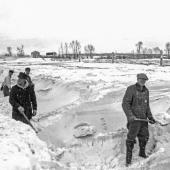Origin Stories
Diving into the history of local trails.
Bozeman is chock-full of history. Every road traveled, every peak climbed, every trail shared—they all hold stories of the past within their land, their water, and even their names. Especially their names.
Peets Hill & Burke Park
Peets Hill, formally known as Highland Ridge, was originally slated to become a 600-home housing development in 1892. At the time, city leaders hoped it would make Bozeman appear larger, to lure in the state capital building or prison. They received Montana State College instead (it later became MSU).
The city tabled construction plans, and landowner John Peets and his son, Earl, ran a dairy farm atop our now popular running, biking, and sledding hill. The dairy closed its doors in the 1940s due to typhoid disease. Earl offered the City of Bozeman the land free of charge, but the City declined.
If you’ve ever taken a close look at the east-facing side of Drinking Horse, you’ll see the very reason this trail got its name.
Then, in 1947, the Burke family (who first settled in Montana in 1878) purchased the land to use as a horse pasture. Both Edmund Burke Sr. and Jr. attended Montana State College. The senior Burke taught chemistry and was the mayor of Salesville (now Gallatin Gateway) from 1924-1927, while the junior opened a law office in Bozeman and served as the Gallatin County attorney for two years.
Even though the Burkes still owned the land, the area was heavily used by outdoor recreationists. Negotiations for preserving public access went on for years, until a host of stakeholders finally settled the debate in 1993 by purchasing the 40-acre parcel and designating it as a city park. Further additions by GVLT and the City of Bozeman in 2008 and 2022 expanded the acreage of the property.
Drinking Horse
Most of us have been up the Drinking Horse trail, but have you spotted the drinking horse itself? If you’ve ever taken a close look at the east-facing side of the mountain, you’ll see the very reason this trail got its name. The shape of the hill, when viewed from Bridger Canyon, resembles a horse drinking from a stream—Bridger Creek, in this case. Public Access was donated in 2000, and the land is now primarily managed by the US Fish and Wildlife Service. Today, it’s a hotspot for hikers and runners.
Marguerite Kirk, an early area resident, grew up in Gallatin Gateway, teaching in public schools and working as a librarian.
Gallagator Trail
Once upon a time, before this trail was lined with runners, walkers, dogs, bikers, and the occasional black bear, the Gallagator served as a railway line to Gallatin Gateway. It was originally known as the Linear Trail, but was nicknamed the Gallagator by railroad passengers for its slow speed. The last railcar ran its tracks in 1978, leaving the land open for potential development. After 10 years of community efforts, the City of Bozeman purchased the land as a linear park.
Kirk Hill Recreation Area
On the south side of town, you’ll find a hill overlooking the Gallatin Valley, hosting aspen groves and old-growth Douglas fir. Marguerite Kirk, an early area resident, grew up in Gallatin Gateway, teaching in public schools and working as a librarian. Not to be underestimated, she once spent three weeks snowshoeing in Yellowstone in winter. Kirk kept her roots in Bozeman, retiring here and later buying the Country Bookshelf. She purchased a small tract of land below Kirk Hill in 1956, and in 1969, she donated it to MSU—requesting the park be dedicated to preserving wildlife and flora. Today, it serves as a linkage from an easily-accessible trailhead to the vast Custer-Gallatin National Forest. With any luck, the highly-visible streaks from a recent logging project will grow in and restore Kirk Hill’s former pristine appearance.
Highland Glen
Highland Glen has been part of Bozeman’s history from the very beginning. Originally serving as a “highland” navigable route from the Gallatin Valley to Bozeman Pass (the surrounding lowlands were strewn with beaver ponds at the time), Highland Glen was used by indigenous people to travel for bison hunts. In 1806, William Clark and his party, which had split from Meriwether Lewis at modern-day Missoula on their return from the Pacific Ocean, became the first non-indigenous Americans to visit the area and walk the paths of Highland Glen. As greater numbers of settlers arrived in the area, this bison-hunting trail was transformed into a wagon path, and became part of the Bozeman Trail around 1864—connecting southern Montana to the Oregon Trail in Wyoming.
Bozeman Health purchased 500 acres on Highland Glen in 1956, and leased out a portion to the Kraft family for agricultural use in the 1960s. In 2013, the GVLT and Bozeman Parks & Recreation partnered with Bozeman Health and the Kraft family to allow public access to the property.
In March 2023, nearing retirement, Vaughn Kraft gave up the lease. It was transferred to the MSU College of Agriculture, for testing new seeds that are better adapted to local growing conditions. Public access will remain under the new lease.
This fall, when you hop on your bike to commute around town, unclip your pup’s leash, or wipe the dirt and sweat from your brow after a lunchtime run or ride, raise a glass or give a shout-out to those who laid the groundwork for our local trails.






























































